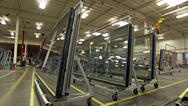Solving an Engineering Problem
- By Anna Rothschild
- Posted 08.25.11
- NOVA
What are composting toilets, computers, and a restaurant doing suspended hundreds of feet above Ground Zero? In this short video, learn how an engineering conundrum allowed the steel company, DCM Erectors, to install modern amenities at the One World Trade Center worksite.
Transcript
Solving an Engineering Problem
Posted: August 25, 2011
NARRATOR: There are 45,000 tons of steel going into One World Trade Center. All this metal will act like a skeleton for the 1,776-foot-tall tower.
Obviously, steel is a strong building material. But, under certain conditions, it can also be quite flexible. For example, if you have giant, unsupported pieces of steel stacked on top of one another in a windy environment, the structure will actually begin to sway back and forth.
That is exactly the situation at One World Trade Center. When the tower is finished, a concrete core will support its steel frame. But during construction, the workers began installing the steel skeleton before they started pouring the concrete. As a result, at any given time there are eight to ten stories of unsupported steel above the concrete level. Without some type of brace, the wind coming off the water, plus the combined weight of the steel and the cranes, would make the building start to sway.
LARRY DAVIS: Because of the nature of the building design⦠it's very loose, it's very flexible, it needs strength, it needs stability.
NARRATOR: To solve this engineering problem, Larry Davis, the President of the steel company DCM Erectors, decided to install temporary steel platforms on lifts into the empty spaces in the building's frame. The platforms brace the steel structure until the concrete is poured. Then he had an inspiration. On top of the platforms, he placed 36 giant, 30-foot-long by eight-foot-wide shipping containers.
LARRY DAVIS: We saw this great big space and we said, "Well, maybe we can put something in here."
NARRATOR: And they did. It started out with just a few office trailersâ¦
LARRY DAVIS: And then we really got crazy and we went right off the deep end.
NARRATOR: Now there are heated and air-conditioned computer stations, banking terminals, and even a Subway sandwich shop! Workers no longer need to leave their sky-high perch to get a bite to eat—an important perk, since lunch breaks are only half an hour, and it can take 40 minutes just to descend to ground level. Davis even installed fully composting toilets—the first of their kind at a construction site in the United States. The shipping containers improve life at the worksite so dramatically that DCM now refers to them as "hotels." And, as the weeks pass and the steel and concrete climb higher, so do the shipping containers, bringing their unusual cargo with them.
Credits
Production Credits
- Video short produced and edited by
- Anna Rothschild
- Original footage
- © WGBH Educational Foundation 2011
Image and Stock Footage Credits
- (main image: leaf, crane, and steel)
- © WGBH Educational Foundation 2011
- (crane)
- © grimgram/istockphoto.com
- (ding sound)
- © acclivity/freesound.org
- (pop sound)
- © HerbertBoland/freesound.org
- (wind sound)
- © medialint/freesound.org
Sound Effects Credits
Related Links
-

Engineering Ground Zero
Designing and building One World Trade Center and the National September 11 Memorial & Museum
-

Walls of Glass
One World Trade Center's glass faíçade may look fragile, but it is extraordinarily tough.
-

The 9/11 Memorial Mock-Up
Architect and designer Michael Arad takes us on a tour of his 9/11 Memorial mock-up.
-

The Memorial Plaques
Visit the factory where the 9/11 Memorial plaques are made.

